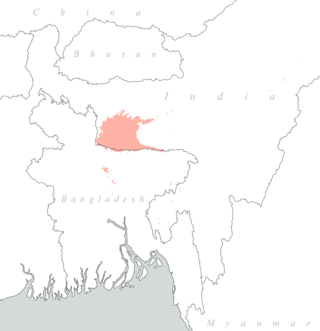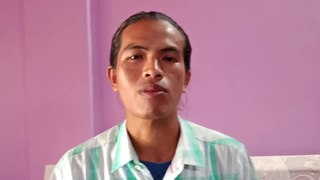Related Research Articles
The Hmar language belongs to the Mizo language branch of the Sino-Tibetan family of languages. The speakers of this language use Mizo language as their second language (L2).

Ri Bhoi is an administrative district in the state of Meghalaya in India. The district headquarters are located at Nongpoh. The district occupies an area of 2378 km² and has a population of 258,840. As of 2011 it is the second least populous district of Meghalaya, after South Garo Hills.

The Karbis or Mikir are one of the major ethnic community in Northeast India. They are mostly concentrated in the hill districts of Karbi Anglong and West Karbi Anglong of Assam.

Garo, also referred to by its endonym A·chikku, is a Tibeto-Burman language spoken in the Northeast Indian states of Meghalaya, Assam, and Tripura. It is also spoken in certain areas of the neighbouring Bangladesh. According to the 2001 census, there are about 889,000 Garo speakers in India alone; another 130,000 are found in Bangladesh.
The Dimasa language is a Tibeto-Burman language spoken by the Dimasa people of the Northeastern Indian states of Assam and Nagaland. The Dimasa language is known to Dimasas as "Grao-Dima" and it is similar to Boro, Kokborok and Garo languages.
Thadou, Kuki, or Thado Chin is a Sino-Tibetan language of the Northern Kuki-Chin sub-branch. It is spoken by the Thadou people in Northeast India. The speakers of this language use Meitei language as their second language (L2) according to the Ethnologue.
Amri or AMRI may refer to:
The Turung language is an endangered Sino-Tibetan language, closely related to Singpho, spoken in seven villages in central Assam. Many Turung people now speak Assamese.

The Karbi language is a Tibeto-Burman language spoken by the Karbi people of Northeastern India.

The Tiwa people, are a Tibeto-Burmese ethnic group primarily inhabiting the Northeast Indian states of Assam, Meghalaya, Arunachal Pradesh, Manipur and Nagaland, and some parts of neighbouring Bangladesh and Myanmar.
Rengma, or Southern Rengma, is an Angami–Pochuri language spoken in Nagaland, India.
The Biate language, also known as Biete language, is a Sino-Tibetan language spoken by the Biate people in several parts of northeast India. Biate is pronounced as Bia-te.
Sakachep also known as Khelma, is a Central Kuki-Chin-Mizo language of Northeast India. Dialects are Khelma, Thangachep, and Sakachep (Ethnologue). VanBik (2009) classifies Sakachep as closely related to Aimol, Anal, Chiru, Kharam, Koireng(Koren), Kom, Lamkang, Purum, Biate, Chorei, Ranglong, Molsom, Hrangkhol, Kaipeng, Bongcher and Thiek-Hmar.
Vaiphei is a Sino-Tibetan language belonging to the Kuki-Chin linguistic subbranch of the Tibeto-Burman group of languages. It is spoken mainly in the Indian state of Manipur and minutely in Mizoram, Assam, Meghalaya, and Tripura. The dialect spoken in Manipur exhibits a least partial mutual intelligibility with the other Mizo/Kukish dialects of the area including Thadou, Hmar, Paite, Simte, Kom and Gangte languages.
Gangte is a Sino-Tibetan language of Kuki-Chin linguistic sub branch of Northeastern India. Its speakers primarily live in Manipur and the adjacent areas of Meghalaya and Assam. The language appears to be homogeneous with no known dialectal variation and exhibits at least partial mutual intelligibility with the other Chin-Kuki-Mizo dialects of the area including Thadou, Hmar, Vaiphei, Simte, Kom and Paite languages. The speakers of this language use Meitei language as their second language (L2) according to the Ethnologue.
Tiwa (Lalung) is a Tibeto-Burman (Sino-Tibetan) language spoken by the Tiwa people in Assam and Meghalaya in North East India. Tiwa language is similar to Boro, Dimasa, Kokborok and Garo language of India.
Rabha is a Sino-Tibetan language of Northeast India. The two dialects, Maituri and Rongdani, are divergent enough to cause problems in communication. According to U.V. Joseph, there are three dialects, viz. Róngdani or Róngdania, Mayturi or Mayturia and Songga or Kocha. Joseph writes that "the Kocha dialect, spoken along the northern bank of the Brahmaputra, is highly divergent and is not intelligible to a Róngdani or Mayturi speaker". Joseph also writes that "[t]he dialect variations between Róngdani and Mayturi, both of which are spoken on the southern bank of the Brahmaputra, in the Goalpara district of Assam and belong to the northern slopes of Meghalaya, are minimal". He concludes the paragraph on dialectal variation with: "The Róngdani-Mayturi dialectal differences become gradually more marked as one moves further west".

The West Karbi Anglong district is a district of the Indian state of Assam. It is a relatively new district formed out of the existing Karbi Anglong district in 2016. The administrative headquarters of the district is located at Hamren. The district is a part of the Karbi Anglong Autonomous Council and is administered according to the provisions of the Sixth Schedule of the Indian Constitution.
Karbi language is officially written in Roman script in Karbi Anglong and Dima Hasao districts of Assam, Meghalaya and Arunachal Pradesh. However, in Kamrup district of Assam prefer mostly the Assamese script.
Bormarjong is a village in the West Karbi Anglong district of Assam State in North East India. It falls under the Amri Development Block and Vidhan Sabha No. 20 Baithalangso ST LAC.
References
- ↑ Amri at Ethnologue (18th ed., 2015) (subscription required)
